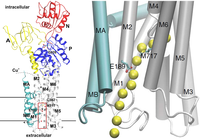How the cells remove copper
New research from Aarhus University provides deeper insight into causes of serious diseases involving copper metabolism. Mapping the mechanism that regulates the transport of copper across the cell membrane and out of the body’s cells actually provides a new understanding of conditions related to chronic imbalance in the body’s level of copper.



We are fundamentally dependent on the presence of copper in the cells of the body. Copper is actually part of the body’s energy conversion and protective mechanisms against oxygen radicals, as well as part of the immune system, and it also has great importance for the formation of e.g. hormones and neurotransmitters.
Imbalance in the body’s copper level has therefore a number of serious consequences for our health, as can be seen with the disorder Wilson’s disease, where the liver accumulates copper in harmful quantities, and the very serious Menkes syndrome, where a congenital defect in the cell's copper dispersion of key enzymes causes e.g. neurological defects, muscular disorders, low blood pressure and osteoporosis, and is typically fatal within the first three years of life.
Both Menkes syndrome and Wilson’s disease are caused by defects in the mechanism that regulates the copper levels in the cells.
A mechanism which researchers at the Danish National Research Centre PUMPkin at Aarhus University have now moved a step closer to understand.
They have shown that the protein that is responsible for the excretion of copper in the cells of the body makes use of a unique transport mechanism.
The results have recently been published in the recognised scientific journal Nature Structural and Molecular Biology.
"The copper pump is a protein that has the function of removing the toxic surplus of copper from the cells. The protein is located partially inside the cell, and partially in the surrounding cell membrane. The parts of the protein which are located inside the cell function almost as a series of cogs, which interlace with one another. Putting it simply, when the cogs rotate they draw on the part of the protein located in the cell membrane, and in this manner a tiny passage opens and closes through the membrane. The copper is pumped out through the passage," says PhD student Oleg Sitsel, co-author of the article.
Crystallisation shows the protein’s function
The copper pump protein that ensures the transport of copper ions through the cell membrane has been mapped by means of crystallisation.
"The protein passes through a phased cycle to perform the pump function.
We have crystallised the protein in different stages and can thus determine precisely when the passage through the cell membrane is open, so the copper ions can be pumped out.
In other words, we have mapped the copper ions’ exit route," explains postdoc Pontus Gourdon who is part of the team - which also comprises PhD student Oleg Sitsel, PhD student Daniel Mattle, laboratory technician Tetyana Klymchuk, laboratory technician Anna Marie Nielsen and Professor Poul Nissen - who have delivered Aarhus University's contribution to the study.
The copper pump gets its fuel from the ATP molecule, which supplies the energy for most of the energy-demanding processes in the body.
Bacteria can be polluted with copper
The results cannot at the present time be translated into a specific treatment, but the new knowledge is nonetheless extremely important for the basic understanding of the causes of diseases related to copper imbalances and why they arise.
In addition, our understanding of the mechanisms of the copper pump can also be used to develop new antibiotics, which can be targeted at blocking the copper pump in harmful bacteria and thereby poisoning the bacteria.
"Now knowing how the pump transports copper out through the cell membrane, we are also closer to being able to say how the copper pump can be taken out of service, so that the copper level in the cell reaches toxic levels. This knowledge can be used in the fight against harmful bacteria by preventing them from excreting themselves with their copper," says Oleg Sitsel.
The copper pump protein, which the researchers have studied, is extracted from the bacterium Legionella pneumophila, which normally can cause the deadly Legionnaires' disease, but which is here cloned in a harmless E-coli strain.
In 2011 the basic properties of the copper pump were mapped – also at Aarhus University – but it is not until now that the researchers have shown exactly how copper is released by the pump. There is still some research to be done into the various phases of the copper pump before the entire puzzle is completed.
Link to the scientific article in Nature Structural & Molecular Biology
For more information, please contact
Professor Poul Nissen
Department of Molecular Biology and Genetics
Aarhus University
pn@mb.au.dk
+45 8715 5508/2899 2295
Postdoctoral Fellow Pontus Gourdon
Department of Molecular Biology and Genetics
Aarhus University
pgo@mb.au.dk
+45 5033 9990
PhD Student Oleg Sitsel
Department of Molecular Biology and Genetics
Aarhus University
oleg@mb.au.dk
+45 5039 5959
